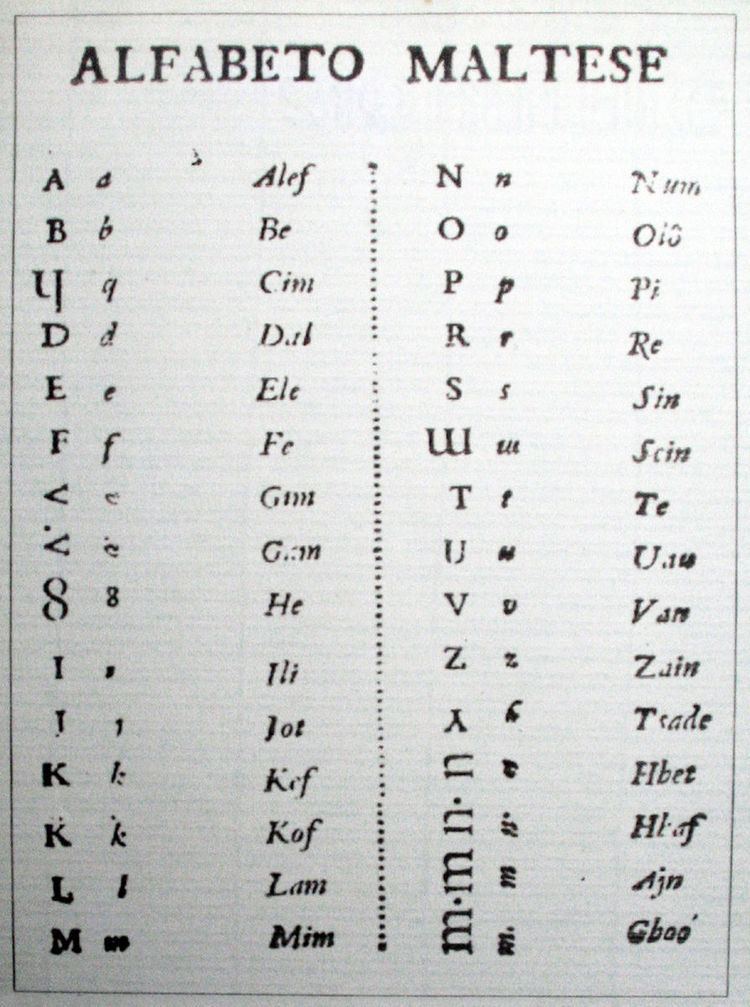 | ||
The Maltese alphabet is based on the Latin alphabet with the addition of some letters with diacritic marks and digraphs. It is used to write the Maltese language, which evolved from the extinct Siculo-Arabic dialect, as a result of 800 years independent development. It contains 30 letters:
Older versions of the alphabet
Before the standardisation of the Maltese alphabet, there were several ways of writing the sounds peculiar to Maltese, namely ċ, ġ, għ, ħ, w, x, and ż.
ċ was formerly written as c (in front of e and i, in Italian fashion). Vella used ç for ċ. ç was used in other books during the 19th century. Rather than using a c with a cedilla (ç), Panzavecchia used a c with ogonek (c̨). A Short Grammar of the Maltese Language used ch for ċ, in English fashion. It was not until 1866 that ċ came to be used.
ġ and g were formerly confused. When they were differentiated, g was written as gk, g, gh and (by Vassalli) as a mirrored Arabic/Syriac gimel resembling a sideways V. On the other hand, ġ was more commonly written as g or j in English fashion. Vella used a g with two dots, but in 1843 reduced it to one dot, instituting today’s ġ.
Until the middle of the 19th century, two għ sounds were differentiated in Maltese. These were variously represented as gh, ġh, gh´, gh˙ and with two letters not represented in Unicode (they resembled an upside down U). Panzavecchia used a specially designed font with a curly gh. A Short Grammar of the Maltese Language used a with a superscript Arabic ayn to represent għ. għ itself was first used in Nuova guida alla conversazione italiana, inglese e maltese.
The letter ħ had the most variations before being standardised in 1866. It was variously written as ch, and as a h with various diacritics or curly modifications. Some of these symbols were used for [ħ] and some for [x]. None of these are present in Unicode. ħ was first used in 1900, although the capital Ħ was used earlier (in 1845) where its lower case counterpart was a dotted h.
w was written as w, u or as a modified u (not present in Unicode).
x was traditionally written as sc or x. Vassalli invented a special character similar to Ɯ, just wider, and Panzavecchia used a sc ligature to represent x.
ż and z were formerly confused. When they were differentiated, z was written as ts, z, ʒ or even ż. On the other hand, ż was written as ż, ds, ts, ʒ and z.
Prior to 1900, k was written as k, as well as c, ch and q (in words derived from Italian and Latin).
Vassalli’s 1796 work contained several new letters to represent the sounds of the Maltese language, which included the invention of several ad-hoc letters as well as the importation of Cyrillic ge, che, sha, and ze. His alphabet is set out in full with modern-day equivalents where known:
A, a = a
B, b = b
T, t = t
D, d = d
E, e = e
F, f = f
[a clockwise-turned V, or a Syriac/Arabic gimel open to the right] = g
[Ч], ɥ = ċ
H, h = h
[like an upside down ȣ]
[like a ɸ,Φ without the ascenders/descenders]
Y, y = j
[vertically mirrored Г] = ġ
З, з
[a clockwise-turned U] = ħ
I, i = i
J, j = j
K, k = k
[I with a small c superimposed on it]
L, l = l
M, m = m
N, n = n
O, o = o
P, p = p
R, r = r
S, s = s
Ɯ, ɯ = x
V, v = v
U, u = u
W, w = w
Z, z = z
Ʒ, ʒ = ż
Æ, æ = final e
To these, five grave accented vowels are also used: Àà; Èè; Ìì; Òò; Ùù
